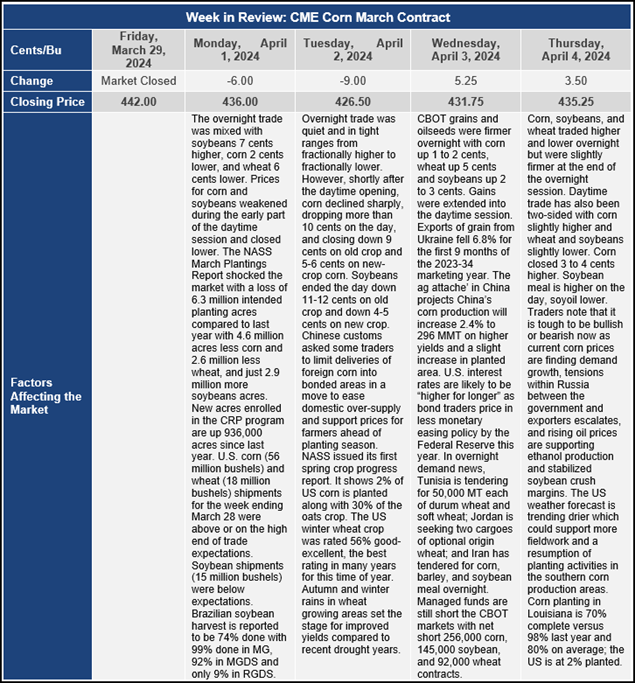Chicago Board of Trade Market News

Outlook
U.S. Federal Reserve Chair Jerome Powell emphasized the task of reducing inflation is ongoing and the central bank requires more assurance of easing price pressures before considering interest rate cuts. But he also reaffirmed the Fed’s intention to cut interest rates this year, despite the recent surge in economic activity, and premises the decision to cut rates on the expectation of declining inflation in the months ahead. Powell highlighted indicators suggesting the labor market is less constrained than in previous years, alleviating concerns of simultaneous increases in wages and prices. Despite market expectations indicating at least three rate cuts this year, Fed officials are expressing caution about easing monetary policy too quickly, aiming to strike a balance between controlling inflation and preventing an economic slowdown. Atlanta Fed President Raphael Bostic has said that rates should likely not be reduced until the fourth quarter of this year.
In the wake of the collapse of the Baltimore bridge blocking that port, efforts to locate and reroute shipments to other ports are underway, with estimates suggesting a weekly trade impact of around $1.7 billion. Major container shipping lines have declared force majeure, indicating that they won’t cover the added transport costs to alternate ports. As a result, shippers and logistics operators are facing increased transportation expenses. Automotive and heavy machinery industries are particularly affected, with car carriers and manufacturers experiencing disruptions and financial losses. The closure of the shipping channel has also led to traffic diversions and increased costs for truckers, affecting their routes and fuel expenses. With regard to exports of agricultural products, in 2023, over 605,000 metric tons (MT) of agricultural products were exported from Baltimore corresponding to nearly $650 million in value. This equates to just 0.3% of total U.S. ag exports by quantity and 0.4% by value. In terms of volume, 415,678 MT of soybeans were exported from Baltimore in 2023, or 0.9% of all U.S. soybean exports, valued at $243 million. In terms of value, the largest export destinations for agricultural products leaving Baltimore were Taiwan, China and Colombia.
Technically the corn market pushed down to support levels below the 50-day moving average and seems to have run out of sellers and the same thing in soybeans. U.S. farmer selling has dried up as prices retreated from last Thursday’s report day highs. We’re hearing that farmers are just not interested in selling corn and soybeans unless basis improves significantly or the market rebounds. The roughly 400-million-bushel disappearance in corn in last week’s USDA Quarterly Stocks Report is also a positive factor. But for prices to move higher, the grain markets will now need some sort of catalyst to get funds to continue to cover their short positions, most likely in the form of weather concerns. As some traders have mentioned, all of the uncertainty of the new crop is ahead of the marketplace.
The pullback in the U.S. dollar index and higher crude oil and energy prices are also supportive. Crude oil is reacting to rising tensions in the Middle East and tightening inventory and is adding some risk premium. Longer-term this is supportive to corn pricing.
